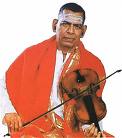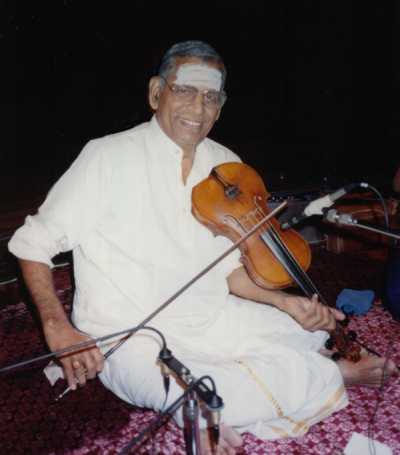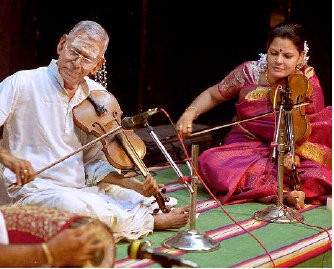Contribute
| M. S. Gopalakrishnan And The Adventure In Violin Playing |
B. P. Purnaprajna
04/02/2009
India has produced some of the world’s greatest musicians among these musicians M. S. Gopalakrishnan (MSG, as he is affectionately called by music lovers) holds a special place. He is indeed a unique figure, for he is a master of both systems of Indian classical music, Carnatic as well as Hindustani. Even more remarkably, he and his father Parur Sundaram Iyer, have evolved a style of playing, famously called the Parur style, which has influenced a generation of violinists. This style, among other things, harmoniously blends the north and south Indian systems, thereby creating a new paradigm in musical interpretation.
MSG’s passion for violin playing manifested itself early. At the age of four, he would take two plantain sticks and pretend that he was playing the violin by holding one of the sticks as the violin and the other as the bow. But his serious training started when he was six years old. Sundaram Iyer was a hard taskmaster. He made sure his two sons, MSG and M.S. Anantharaman, would get up at four every morning and practice the violin. Failing to wake up would surely invite a generous sprinkling of cold water on their faces. Many years of rigorous training under his father’s tutelage followed. Sundaram Iyer had a well-rounded regimen for his sons. Everyday, there would be the practice of basic exercises, learning new compositions, improvising on a theme and a mandatory listening of other musicians on the radio in the evening hours.
MSG made phenomenal progress and gave his first concert when he was only eight years old. Barely in his late teens, his astonishing virtuosity, literally unseen in the music world, and his uncanny ability to anticipate the main artist during accompaniment created a sensation. When he was nineteen years old, the great western violinist Yehudi Menuhin heard him play raga Kalyani. He was so taken by this young man’s playing that he came and observed MSG’s fingers and exclaimed “I have not heard such violin in all my travels! How superbly this young Indian is playing our instrument.â€
Triumph after triumph followed and one of the highlights of his early career was the national program on All India Radio in 1967. A few words need to be said about this. This was a landmark in the annals of Indian classical music. MSG’s interpretation of Carnatic classical music was radical and very new. Played on gut strings, anyone who listens to the recording today would surely realize a phenomenon was taking place back then. In the improvisational part of kriti ‘Manavyala’ set in raga Nalinakanti, one can hear new sounds on the violin. The improvisation blended the classical and the folk, the violin was transformed through the sheer virtuosity and imagination into a variety of instruments, ranging from the Shenai, the Flute, the sitar and the sarod, clearly demonstrating the universality of the violin as an instrument when handled by a master of this caliber. Many people, who had heard this program live, described it to me as an unparalleled musical experience.
It is not possible to characterize his violin playing through deconstruction of conventional parameters that define excellence. There are many things that go on simultaneously when he is playing and they are not quantifiable. Moreover, the whole effect is not the sum of its parts. But the following stand out: his magnificent and towering technical virtuosity, the unsurpassed tonal beauty, the purity of the notes, the amazing clarity of his fingering, his smooth bowing, be it in the slow movement or the super fast staccato and above all his tremendous musical imagination. Like all great masters, his virtuosity is always subordinate to musical aesthetics. His great self control and super human powers of concentration are well known and are talked about in the music circles. In all of this he compellingly reminds us of the great western violinist Jascha Heifetz.
For MSG, violin playing is an adventure. Like a bold explorer, he has waded through the jungle of the musical expression and has made what had seemed technically impossible, possible for the rest of us, thereby raising the consciousness of violin playing for future generations. This can already be seen in the burst of technical virtuosity, in the last few decades, among the younger violinists who have been influenced by his deeply researched virtuoso techniques and his musical interpretation.
His is a life in music and music is his life. His commitment to music is total and utterly sincere. A spiritual man of great discipline and simple habits, he regards music as a means of worshipping God. Three themes repeat in all of one’s conversations with him: reverence to his guru, grace of the lord and violin practice.
LearnQuest Academy will honor M. S. Gopalakrishnan at its 4th annual music conference to be held on April 10, 11 and 12 at the Fine Arts Center of Regis College, Weston, MA. He will perform Carnatic and as well as a Hindustani-Carnatic violin jugalbandi. MSG will be accompanied in this concert by two violinists, daughter M. Narmada and son, M. Suresh. Narmada is one of the leading Carnatic violinists and is the chief torchbearer of the Parur School. She has a Ph.D in music from Delhi University under the guidance of the well known sitarist Debu Chaudhary and musicologist K. G. Ghinde. Her thesis was published as a book, an important contribution to the Indian music literature. Suresh is a young up coming violinist. His passion, humility and enthusiasm for music are obvious for those who have come in contact with him.
MSG has produced a number of students. H. K. Narasimhamurthy, the well known Carnatic violinist and a teacher of genius, who has produced tens of first rate violinists and who are carrying the Parur style to the 21st century, is one of them. Other prominent students of MSG include C. N. Chandrashekar, a staff artist at All India Radio, Bangalore, and H. N. Bhaskar, a young, talented and much sought after violinist.
MSG has accompanied all the major Carnatic artistes. He has played Jugalbandi with leading Hindustani and Carnatic instrumentalists as well. As a young violinist he accompanied such stalwarts as D. V. Paluskar and Omkarnath Thakur to much acclaim.
About the author:
B. P. Purnaprajna is a highly accomplished violinist. He has received rigorous training in music from H. K. Narasimhamurthy, a well known Carnatic violinist and a great teacher from Mysore, India. He closely follows the Parur style of violin playing. Purnaprajna has given concerts in India and abroad. During the mid 1990’s, while he was in the Boston area, he taught violin at LearnQuest Academy of Music. Currently, he is a professor of Mathematics at the University of Kansas in Lawrence, KS.
You may also access this article through our web-site http://www.lokvani.com/


